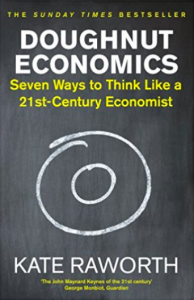 Doughnut Economics by Kate Raworth
Doughnut Economics by Kate Raworth
Chelsea Green Publishing, 2017
Paperback
ISBN 160358675X, 9781603586757
Kate Raworth is, in her own words, an economist focused on exploring the economic thinking needed to address the 21st century’s social and ecological challenges. Her ideas are being increasingly acclaimed, notably among sustainable development thinkers and progressive business and political activists. I heard her speak at this year’s Greenbelt Festival and I have to say she is a brilliant oral communicator. She held her audience spellbound for an hour.
I therefore came to read her book Doughnut Economics with high expectations. It is a fine book but I do not think she writes quite as well as she speaks. This was a heavier read than I expected, but it’s certainly worth the effort.
Kate is convinced that the images or diagrams economists use are highly influential. She bemoans the influence of the US economist Paul Samuelson, whose 1948 Circular Flow diagram, depicting income flowing round the economy as if it were water flowing round plumbed pipes, held sway for several decades through his Economics textbook. She believes this made simplistic assumptions about the market, business, finance, trade and the state, but ignored the household, the commons, society, the earth and the crucial phenomenon of power.
Kate proposes instead the image of the doughnut. Below the inner ring of the doughnut, its social foundation, lie critical human deprivations like hunger and illiteracy. Beyond the outer ring of the doughnut lies critical planetary degradation such as climate change and biodiversity loss. Beyond the two – on the doughnut – lies a safe and just space where human beings can flourish.
How can we change our ways so that more people on this earth can thrive while recognising ecological limits? She suggest seven key steps: Change the Goal, See the Big Picture, Nurture Human Nature, Get Savvy with Systems, Design to Distribute, Create to Regenerate, and Be Agnostic about Growth. These sound rather abstract, and some of her discussion is academically technical, but she has helpful examples of all these steps having positive results – notably in the are of imaginative recycling. Nevertheless, the benefits are not always straightforward. She cites the Californian firm Newlight Technologies which – remarkably – turns methane emissions from cows into a plastic called AirCarbon, but anything plastic poses a recycling challenge.
Kate Raworth’s most radical idea is to urge agnosticism about growth. Economic goal has become an idol of our time, and we should repent of it. The thrust of her final chapter seems to be that we should aim for a just and safe space, and if growth comes as a by-product, that’s a bonus. It should not be our aim. Early in the chapter she comes up with this conundrum:
-
No country has ever ended human degradation without a growing economy.
-
And no country has ever ended ecological degradation with one.
Later on, though, she cites international data that between 2000 and 2013 Germany, the UK and the US all experienced significant growth in GDP while their consumption-based CO2 emissions fell (albeit by small amounts). These figures require further examination. They suggest that it may be possible – through wise national economic policies, especially in the area of energy choice – to combine economic growth and sustainable development. The boundaries of the doughnut may have a little more ‘give’, there may be more scope for expansion, than Kate acknowledges.
At the end of this book I found myself largely persuaded by Kate’s analysis, but wondering what difference faith in God makes. It should surely increase our repentance for the misuse we humans have made of the world’s resources, because we have been poor stewards of the created order. But we also believe that God has not abandoned his world, and ultimately its future lies in his/her hands. Although we must act urgently to reform our economics and put things right, let us not make the mistake of thinking we can save the world on our own.
Purchase Doughnut Economics from Amazon.